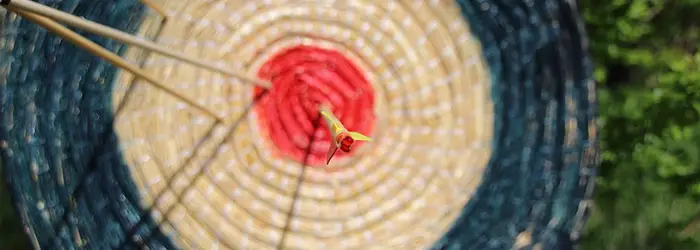Anyone familiar with a bow can tell how exhilarating it is when their arrow hits the target, dead center. It is an out-of-the-world feeling. The disappointment or loss you feel when you aim at a target and fall short on it can be intense as well. Wear and tear cause issues with shooting, which can reduce your accuracy, and cause the bow to under-deliver. So, how often do bows need to be tuned?
On average, a bow should be tuned once every 2 to 3 years. It’s recommended that you check the tuning if you haven’t used the bow in a while, if anything major has changed with how you use the bow or if you added any accessory.
But there’s more to know whether you need to tune your bow, and in this post, we’ll consider the different aspects you need to consider.
When should you tune a bow?
Here are a few things you might want to keep in mind while considering whether your bow needs tuning.
Occasional check-up
It costs nothing to check whether your bow is tuned, does it? Occasionally checking to see if something has changed is a wise thing to do since one can immediately find anything wrong to adjust quickly.
On average, you’ll find that if you haven’t changed your setup, you’ll need to tune your bow once every 2-3 years. You should check tune much more often though – always make sure your equipment is set up right before using it.
To perform the tune check-up, you should
- Perform a quick examination of the bow settings.
- Check the bow integrity – tight screws, the material of the bow, etc.
- Shoot the bow a few times with short yardage and check how off you are.
Professionals may not need to do this quite often as they have been used to finding faults and fixing them through the feel of the bow. Still, less experienced bowhunters will find this helpful as it will bring them to understanding and measuring their settings.
Tuning whenever there is a significant change in the equipment.
If you’ve changed accessories or parts of the bow, it’s recommended that you also tune the bow.
Replacing strings, stabilizer weight, nock height, and even new arrows may alter the balance of the bow. Tuning it will help reset it to a better state.
Therefore, the frequency of the tuning is dependent on how often you change the equipment.
Annual Tune-up
While tuning can be performed regularly as checking and performing mini-inspections, visiting a mechanic’s workshop annually to update and upgrade your equipment is very recommended.
You cannot afford to wait until your bow is faulty or damaged to see a bow mechanic; annual visits will enhance your performance and safety.
Vibrating bowstring, loose bolts, any misalignments, cam shift, and other problems you may have overlooked are what the mechanic will look into to give you a top-notch service. You could even ask about issues that your bow might have in the future to look for when checking tune later.
How to determine if your bow needs maintenance
When equipment is used continuously without being kept in good working order, it can break down entirely over time. The longevity of a bow is only ensured when maintained. To keep your bow in good condition, you must know how to maintain it.
How is it done? To carry out maintenance, you should consider the following:
Bowstring inspection
No component of the bow is at risk of wear and tear as the bowstring. The bowstrings are pulled all the time; they do the most work and often suffer its brunt. Below are a few things to watch out for when bow-hunting:
Before shooting each day, look carefully at your bowstrings to check for any inconsistencies. Try to feel and see if it is smooth. If you feel the string is rough or ragged, you can apply a bowstring wax to smoothen it.
If it persists, you’ll need to replace the bowstring. Do not attempt to replace it on your own or shoot with it; it could cause you serious harm.
Make sure to focus on sensitive parts of the string (the servings, D-loop, the string near the cams) and not just the nock. Make sure they align correctly and fastened securely to complete your inspection.
You can maintain your bowstring by regularly waxing it. Applying bowstring wax after inspecting will not only help smoothen your string but will also increase its lifespan.
An adequately maintained bowstring can last for 2-3 years.
Avoid Dry-firing
Dry-firing, also known as “dry-loosing,” means releasing a drawn bow without an arrow. It should be avoided by all means because without the bulk of the arrow to contain the elastic energy cast, the energy is rather burnt out through the vibration of the bowstring. It can do severe damage to the bow itself.
Dry firing a modern high energy bow once may cause a combination of cable slide failure, cam warping, string failure, cracked limbs, bet axles, or even cause the bow to shatter.
Although other times are that dry firing may not result in apparent damage, it needs to be thoroughly inspected for damage before shooting again.
Read more about why dry firing a bow is bad.
Storage
How you store your bow to a large extent determines its longevity; if you place little significance on your bow’s storage place, then you are responsible for any damage suffered or the need for constant repairs. The suggestions below will help improve the life quality of your bow:
Get a case for your bow: Getting a case for your bow will help reduce the worries of tear or wear. During transportation, the cases will serve as a shelter to the bow and protect it from extreme conditions. There are two types of cases: the soft and the hard case; although they both protect the bow from harsh conditions, the hard case is better when traveling with a bow.
But if you do not have a case, make sure you store it high up somewhere safe.
Avoid storing in place with high temperature: the strings and cables of a bow are more susceptible to erosion when exposed to heat. Special attention needs to be taken to the environment that hosts the bow to ensure that the temperature is average and moderate for your bow.
Before storing your bow, ensure it is dirt-free and unsullied, especially when you have been outdoors; this will in no small way improve its quality of life.
Conclusions
The frequency of tuning a bow depends on how often the equipment is changed. Check tuning may or may not be frequent depending on the expertise of the bowhunter; it is, however, advised that you should observe regular maintenance checks to increase the bow’s efficiency.



